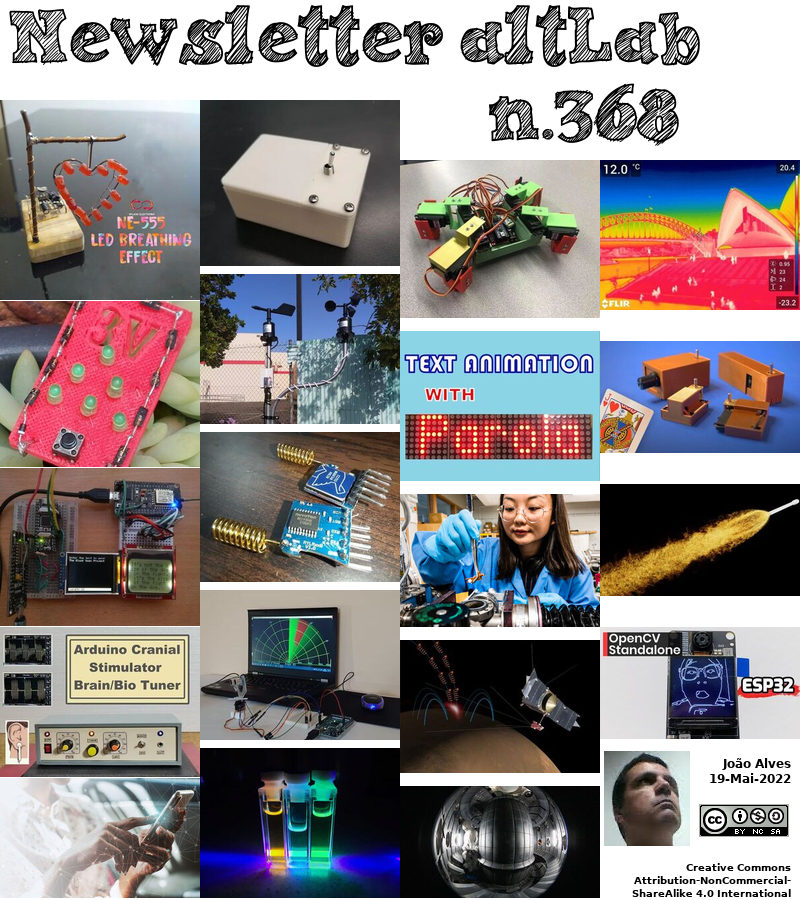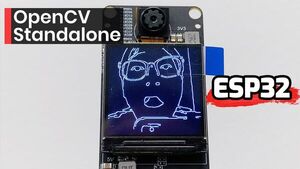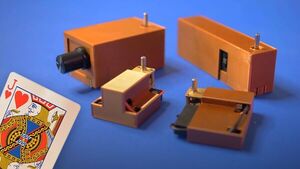2022-05-19 - Nº 368
Editorial
Esta é a Newsletter Nº 368 que se apresenta com o mesmo formato que as anteriores. Se gostar da Newsletter partilhe-a!
Todas as Newsletters encontram-se indexadas no link.
Esta Newsletter tem os seguintes tópicos:
Faz hoje anos que nascia, em 1868, o engenheiro civil e geodésico norte-americano John Fillmore Hayford. Ele estabeleceu a ciência moderna da geodésia, e fez uma determinação precisa da forma e tamanho elipsoidal da terra (1909). A União Internacional de Geodésia e Geofísica adoptou os cálculos de Hayford em 1924. Esta elipsóide internacional tem um achatamento de exactamente 1 parte em 297. O raio equatorial da Terra é de 6.378.388 m. O raio ao longo do eixo polar é então 1/297 inferior a isso ou 6.356.912 m. (Surpreendentemente, os EUA não adoptaram este dado.) A teoria de isostasia de Hayford deu que a pressão exercida pela crosta terrestre é aproximadamente a mesma em todo o globo, independentemente da natureza da superfície (por exemplo, terras baixas ou montanhas). Com modificações, esta teoria é agora utilizada para explicar fenómenos dentro da crosta. Na altura da sua morte, investigava os problemas ligados à evaporação e ao nível da água dos Grandes Lagos.
Faz também hoje anos que nascia, em 1914, o bioquímico austríaco-britânico Max Perutz. Ele partilhou o Prémio Nobel da Química de 1962 pela sua análise da difracção de raios X da estrutura da hemoglobina, a proteína que transporta o oxigénio dos pulmões para os tecidos através das células sanguíneas. Ele identificou que a hemoglobina é construída de quatro cadeias de proteínas enroladas juntas, e que a molécula muda de forma quando o oxigénio é adicionado. Perutz estava também interessado em estudar glaciares, fazendo medições que foram as primeiras a mostrar diferentes taxas de fluxo em diferentes partes do mesmo glaciar.
Faz igualmente hoje anos que nascia, em 1918, o físico holandês-americano Abraham Pais. Ele foi responsável pela investigação que se tornou nos blocos de construção da teoria das partículas elementares. Ele escreveu Subtil É o Senhor: A Ciência e Vida de Albert Einstein, que é considerada a biografia definitiva de Einstein. Na Holanda, o seu doutoramento em física foi atribuído a 9 de Julho de 1941, cinco dias antes de um prazo nazi que proibia os judeus de receberem diplomas. Mais tarde, durante a II Guerra Mundial, enquanto se escondia para fugir à Gestapo, elaborou ideias em electrodinâmica quântica que mais tarde partilhou ao trabalhar com Niels Bohr (Jan - Ago 1946). Em Setembro de 1946, foi para os EUA para trabalhar com Robert Oppenheimer em Princeton, onde Pais contribuiu para os fundamentos da teoria moderna da física das partículas.
Por fim, faz hoje anos que nascia, em 1955, o cientista da computação canadiano James Gosling. Ele ficou conhecido por ser o fundador e arquitecto principal por detrás da linguagem de programação Java. Ele teve a ideia da Java VM enquanto escrevia um programa para portar software de um PERQ, traduzindo o Perq Q-Code para VAX assembler e emulando o hardware. É geralmente creditado por ter inventado a linguagem de programação Java em 1994. Criou o desenho original do Java e implementou o compilador original e a máquina virtual da linguagem. Gosling traça as origens da abordagem aos seus primeiros tempos de estudante, quando criou uma máquina virtual de p-code para o computador DEC VAX do laboratório, para que o seu professor pudesse executar programas escritos em UCSD Pascal. No trabalho que conduziu ao Java na Sun, ele viu que a execução neutra em termos de arquitectura para programas amplamente distribuídos poderia ser alcançada através da implementação de uma filosofia semelhante: programar sempre para a mesma máquina virtual. Outra contribuição de Gosling's foi o programa "bundle", conhecido como "shar".
Na Newsletter desta semana apresentamos diversas noticias, artigos científicos, projetos de maker e alguns vídeos interessantes.
 João Alves ([email protected])
João Alves ([email protected])
O conteúdo da Newsletter encontra-se sob a licença  Creative Commons Attribution-NonCommercial-ShareAlike 4.0 International License.
Creative Commons Attribution-NonCommercial-ShareAlike 4.0 International License.
Novidades da Semana
Outras Notícias
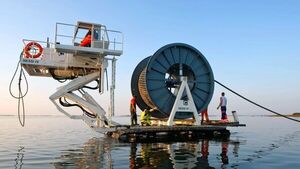
The Equiano submarine cable, which connects Africa and Europe, arrives in Portugal
"Equiano, the submarine cable that connects Africa to Europe, is arriving in Portugal. Equiano, which was introduced three years ago, starts in Western Europe and runs along the west coast of Africa and connects Portugal to South Africa, increasing connectivity and opportunities for engagement between European and African countries. This cape, named after Olaudah Equiano, a Nigerian-born writer and abolitionist who was enslaved as a child, offers state-of-the-art infrastructure. The space division multiplexing (SDM) technology on which Equiano is based will increase cable capacity in the region for a variety of network operators and Internet service providers in Europe and Africa.either for your own use or to provide to third parties. Thanks to its branching units along the route, this system will provide the flexibility to dynamically respond to the capacity needs of these network operators as well as Google Cloud customers - and will create opportunities to extend connectivity to other African countries in the coming years. years, increasing the value of this infrastructure in many areas." [...]
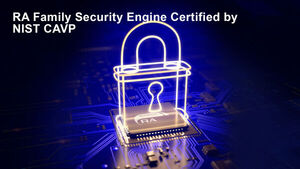
Renesas RA Family MCUs Achieve CAVP Certification for Comprehensive Suite of Cryptographic Algorithms
"RA Family of 32-bit Arm Cortex-M Microcontrollers Offers Ultimate IoT Security with Renesas’s Secure Crypto Engine (SCE) and Arm TrustZone Renesas Electronics Corporation (TSE:6723), a premier supplier of advanced semiconductor solutions, today announced that the security engine of its RA Family of 32-bit Arm® Cortex®-M microcontrollers (MCUs) has been certified by the National Institute of Standards and Technology (NIST) Cryptographic Algorithm Verification Program (CAVP). The drivers to utilize the certified SCE9 Protected Mode are included in the RA Family Flexible Software Package (FSP) v3.6.0 and later. The Renesas RA6M4, RA6M5, RA4M2, and RA4M3 MCU Groups all received NIST CAVP certification of a comprehensive suite of cryptographic algorithms, including multiple modes of Advanced Encryption Standard (AES), hashing, Rivest Shamir Adleman (RSA) and Elliptic Curve Cryptography (ECC) key generation and authentication, Key Agreement Schemes, and Deterministic Random Bit Generator (DRBG). NIST CAVP certification provides independent verification of the correct implementation of the cryptographic algorithms, which is vital to ensure connectivity interoperability. Renesas announced last year that RA devices received both PSA Certified Level 2 and Security Evaluation Standard for IoT Platforms (SESIP) certifications. “With CAVP certification, in conjunction with the existing SESIP1 and PSA Certified Level 2, Renesas provides the industry’s most comprehensive IoT security solutions,” said Roger Wendelken, Senior Vice President in Renesas’ IoT and Infrastructure Business Unit." [...]

STMicroelectronics reveals low-noise, low-voltage regulator for energy-conscious applications
"STMicroelectronics’ LD56020 200mA low-dropout voltage regulator operates with a supply from 1.1V to 5.5V and has low output noise for applications that demand excellent stability and long battery runtime. Ideal for mobiles, vision sensors, and wireless modules, the competitively priced LD56020 has extremely low dropout voltage of just 190mV (max. at full load) and maximum quiescent current of 25µA at light load. An external enable pin permits control logic to put the regulator into standby mode, which reduces current below 0.1µA. With supply-voltage rejection (SVRIN) of 90dB (1kHz, 20mA) and output noise of just 8.8µVRMS (10Hz to 100kHz), the LD56020 provides a clean power rail for low-voltage digital circuitry. The circuit is stabilized with only one small ceramic capacitor at each of the input and output terminals." [...]
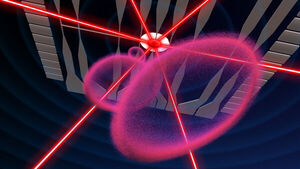
Ultracold Bubbles on Space Station Open New Avenues of Quantum Research
"Inside NASA’s Cold Atom Lab, scientists form bubbles from ultracold gas, shown in pink in this illustration. Lasers, also depicted, are used to cool the atoms, while an atom chip, illustrated in gray, generates magnetic fields to manipulate their shape, in combination with radio waves. Credit: NASA/JPL-Caltech Produced inside NASA’s Cold Atom Lab, the bubbles provide new opportunities to experiment with an exotic state of matter. Since the days of NASA’s Apollo program, astronauts have documented (and contended with) how liquids behave differently in microgravity than they do on Earth – coalescing into floating spheres instead of bottom-heavy droplets. Now, researchers have demonstrated this effect with a much more exotic material: gas cooled to nearly absolute zero (minus 459 degrees Fahrenheit, or minus 273 degrees Celsius), the lowest temperature matter can reach. Using NASA’s Cold Atom Lab, the first-ever quantum physics facility aboard the International Space Station, researchers took samples of atoms cooled to within a millionth of a degree above absolute zero and shaped them into extremely thin, hollow spheres." [...]

New Real-Time Platform Root of Trust Provides an Entire Chain of Trust for System Platforms
"Microchip’s Trust Shield family provides an end-to-end solution for protecting data center, telecommunication and networking systems against rapidly evolving security threats As the market need for security evolves, platforms must also evolve quickly to defend against cyberattacks during start-up, real-time and system updates. With these new market threats, designers cannot assume the equipment they are using is trustworthy and they must start looking to new technology to secure their systems. Microchip Technology Inc. (Nasdaq: MCHP) today announced its fully configurable microcontroller-based CEC1736 Trust Shield family that solves this challenge by going beyond NIST 800-193 Platform Firmware Resiliency guidelines with runtime firmware protection that anchors the secure boot process while establishing an entire chain of trust for the system platform. The CEC1736 solution extends Microchip’s offering for ensuring the cyber resiliency of end equipment. It is a fully configurable real-time platform root of trust that enables runtime firmware protection in the SPI Flash and I2C/SMBus filtering against runtime attacks. The attestation feature provides trustworthy evidence to ensure that critical devices in the platform are authentic." [...]
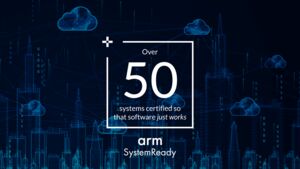
Major milestones for Arm SystemReady in driving ecosystem standards
"The data center market is a thriving and innovative one, but to continue to scale the industry needs to tackle issues around fragmentation, finding the right balance between standardization where it makes sense, and differentiation where it matters. Arm introduced the SystemReady program in 2020 to address these challenges, supported by a broad set of partners from across the ecosystem. SystemReady provides a formal set of compute platform definitions to cover a range of systems from the cloud to IoT and edge, helping software 'just work' seamlessly across a vibrant, diverse ecosystem of Arm-based hardware. Today, we’re sharing some significant milestones for the SystemReady program, including some exciting “firsts” in the Arm-based server and virtual machine space: The Microsoft Azure Ampere Altra Arm-based server has achieved SystemReady SR certification, the first cloud solution provider (CSP) server to do so The Azure Virtual Machines series featuring Ampere Altra Arm-based processors are the first virtual systems to be certified under the new Arm SystemReady Virtual Environment (VE) certification The Arm SystemReady program has reached over 50 certifications since its launch only 18 months ago, demonstrating tremendous momentum Microsoft leads the way in driving critical standards Microsoft has been a strong supporter and collaborator on SystemReady since its inception, and these certifications not only illustrate the company’s leadership in driving standards, but also pave the way for more industry players to embrace the SystemReady approach and ultimately benefit from it. “At its core, the Arm SystemReady compliance certification program preserves the investments that we and customers make in our software stacks," said Arun Kishan, Technical Fellow and Corporate Vice President (CVP), Microsoft. “For Microsoft Azure, the SystemReady platform certification means we can easily move from one generation to another." [...]

STMicroelectronics and MACOM RF Gallium-Nitride-on-Silicon prototypes achieve technology and performance milestones
"STMicroelectronics (“ST”) (NYSE: STM), a global semiconductor leader serving customers across the spectrum of electronics applications, and MACOM Technology Solutions Holdings Inc. (“MACOM”) (NASDAQ: MTSI), a leading supplier of semiconductor products for the Telecommunications, Industrial and Defense and Datacenter industries, have announced the successful production of radio-frequency Gallium-Nitride-on Silicon (RF GaN-on-Si) prototypes. With this achievement, ST and MACOM will continue to work together and enhance our relationship. RF GaN-on-Silicon offers high potential for 5G and 6G infrastructure. The long-term incumbent RF power technology, laterally-diffused metal-oxide semiconductor (LDMOS), dominated early-generation RF power amplifiers (PAs). GaN can offer superior RF characteristics and significantly higher output power than LDMOS for these RF PAs. Further, it can be manufactured on either silicon or silicon-carbide (SiC) wafers." [...]
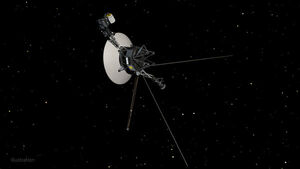
Engineers Investigating NASA’s Voyager 1 Telemetry Data
"While the spacecraft continues to return science data and otherwise operate as normal, the mission team is searching for the source of a system data issue. The engineering team with NASA’s Voyager 1 spacecraft is trying to solve a mystery: The interstellar explorer is operating normally, receiving and executing commands from Earth, along with gathering and returning science data. But readouts from the probe’s attitude articulation and control system (AACS) don’t reflect what’s actually happening onboard. The AACS controls the 45-year-old spacecraft’s orientation. Among other tasks, it keeps Voyager 1’s high-gain antenna pointed precisely at Earth, enabling it to send data home. All signs suggest the AACS is still working, but the telemetry data it’s returning is invalid." [...]

Intel Open-Sources SYCLomatic Migration Tool to Help Developers Create Heterogeneous Code
"Intel has released an open source tool to migrate code to SYCL1 through a project called SYCLomatic, which helps developers more easily port CUDA code to SYCL and C++ to accelerate cross-architecture programming for heterogeneous architectures. This open source project enables community collaboration to advance adoption of the SYCL standard, a key step in freeing developers from a single-vendor proprietary ecosystem. “Migrating to C++ with SYCL gives code stronger ISO C++ alignment, multivendor support to relieve vendor lock-in and support for multiarchitecture to provide flexibility in harnessing the full power of new hardware innovations. SYCLomatic offers a valuable tool to automate much of the work, allowing developers to focus more on custom tuning than porting.” –James Reinders, Intel oneAPI evangelist While hardware innovation has led to a diverse heterogeneous architectural landscape for computing, software development has become increasingly complex, making it difficult to take full advantage of CPUs and accelerators. Today’s developers and their teams are strapped for time, money and resources to accommodate the rewriting and testing of code to boost application performance for these different architectures. Developers are looking for open alternatives that improve time-to-value, and Intel is providing an easier, shorter pathway to enabling hardware choice." [...]

Microchip Introduces Fully Integrated Precise Time Scale System
"Enables Nations to Operate an Independent Time Scale Back-up to GNSS to Protect Critical Infrastructure The strength of a nation’s infrastructure is increasingly dependent on the accuracy of time. With pervasive cybersecurity threats to Global Navigation Satellite Systems (GNSS), utilizing an alternative time system is a matter of national security. To address this need, Microchip Technology Inc. (Nasdaq: MCHP) today announces its Precise Time Scale System, a world-class timing system that is traceable to Universal Coordinated Time (UTC) and not dependent on GNSS—providing nations, institutions, critical infrastructure operators and scientific labs with complete control over the time source that their infrastructure depends on. The Precise Time Scale System (PTSS) is a fully integrated system capable of providing timing accuracies comparable to the world’s best national laboratories. The core products integrated into the PTSS are: - SyncSystem 4380A Time Scale Edition generates an autonomous time scale derived from combining several highly accurate independent clocks with a multi-channel instrument for measuring and comparing clock performance. - Time Scale Orchestrator is a software platform providing a unified view with a built-in database that integrates the management, monitoring, alarming, and reporting functions of the individual products that form the time scale system." [...]

Nexperia further expands its offering of Clip-bonded FlatPower packaged diodes with new automotive CFP2-HP devices
"Nexperia, the expert in essential semiconductors, today announced the release of 14 rectifiers for power applications in its new CFP2-HP (Clip-Bonded FlatPower) packaging. Available in standard and AEC-Q101 versions, these include 45 V, 60 V and 100 V Trench Schottky rectifiers (with 1 and 2 A options) including the PMEG100T20ELXD-Q, a 100 V, 2 A Trench Schottky barrier rectifier. For applications requiring hyperfast recovery Nexperia has also added the 200 V, 1 A PNE20010EXD-Q rectifier to the portfolio. In modern car architectures the number of electronic control units (ECU) is gradually being reduced in favor of fewer high performing, feature-rich ECUs responsible for front axle, rear axle and body control. As a result, the component density of these units is dramatically increasing and in order to realize these higher density designs, manufacturers increasingly rely on modern multilayer PCBs. The vertical thermal design on these multilayer PCBs enables designers to save up to 75% of board space with CFP2-HP compared to using a device in a SMA package, while still maintaining the same level of electrical performance." [...]

Study on Collaboration with Fusion Fuel Regarding Water Electrolysis Solutions
"Toshiba Energy Systems and Solutions Corporation (head office: Kawasaki City, Kanagawa Prefecture; president and CEO: Takao Konishi; hereinafter, “Toshiba ESS”)is pleased to announce that it has reached an agreement with Fusion Fuel Green PLC (hereinafter, “Fusion Fuel”), an European green hydrogen technology company, to study procurement, manufacturing, sales process, and technical collaboration, aimed at expanding sales of electrolyzers in markets such as Europe and Australia. As part of this collaboration, Fusion Fuel will evaluate the use of Toshiba ESS membrane electrode assemblies (MEAs) in its proprietary Proton-Exchange Membrane (PEM) eletrolyzers. MEAs are a core component of PEM electrolyzers, and those under development by Toshiba ESS are highly cost-competitive and require the use of significantly less catalyst than conventional solutions. In addition, Toshiba ESS will explore using the local sales channels it has developed in areas such as the thermal power business to expand sales of Fusion Fuel’s PEM electrolyzers in Australia and other countries. Furthermore, the two companies will also explore potential collaboration for future sales of Toshiba ESS solid oxide electrolysis cells (“SOEC”*1), which Toshiba ESS targets bringing to market in 2025. Development of the green hydrogen economy has accelerated amidst the mobilisation of significant funding support in Europe and Asia for hydrogen projects and electrolyzer technology as part of a broader decarbonization initiative." [...]

STMicroelectronics introduces single-channel load switches for applications with high startup current
"STMicroelectronics has released single-channel versions of its programmable high-side switches, the IPS1025H and the IPS1025H-32. With built-in protection for undervoltage, overvoltage, overload, and overtemperature, they enable the intelligent driving of capacitive, resistive, or inductive loads, which draw high startup current. The internally programmed current limit differentiates between the IPS1025H and IPS1025H-32. The IPS1025H limit is 2.5A and it is 5.7A in the IPS1025H-32. In addition to the main current limit, each switch has a secondary, user-programmable limit for handling capacitive loads with high initial startup current. The limit value and duration are set using external resistors and a capacitor." [...]

NASA’s InSight Still Hunting Marsquakes as Power Levels Diminish
"Dusty solar panels and darker skies are expected to bring the Mars lander mission to a close around the end of this year. NASA’s InSight Mars lander is gradually losing power and is anticipated to end science operations later this summer. By December, InSight’s team expects the lander to have become inoperative, concluding a mission that has thus far detected more than 1,300 marsquakes – most recently, a magnitude 5 that occurred on May 4 – and located quake-prone regions of the Red Planet. The information gathered from those quakes has allowed scientists to measure the depth and composition of Mars’ crust, mantle, and core. Additionally, InSight (short for Interior Exploration using Seismic Investigations, Geodesy and Heat Transport) has recorded invaluable weather data and studied remnants of Mars’ ancient magnetic field. “InSight has transformed our understanding of the interiors of rocky planets and set the stage for future missions,” said Lori Glaze, director of NASA’s Planetary Science Division." [...]

NASA puts ISS spacewalks on hold to investigate water leak
"NASA is continuing to investigate water that leaked into a spacesuit helmet during a spacewalk earlier this year and is holding off on future spacewalks until engineers can resolve the problem. The leak took place during the most recent spacewalk from the U.S. segment of the station March 23, involving NASA astronaut Raja Chari and European Space Agency astronaut Matthias Maurer. At the end of the nearly seven-hour spacewalk, Maurer reported that water had pooled on his visor, although the thin layer of water, about 20 to 25 centimeters across, did not pose an immediate threat to him. NASA had provided few updates about the water leak since the incident. However, at a May 12 meeting of NASA’s Aerospace Safety Advisory Panel (ASAP), Susan Helms, a former NASA astronaut who serves on the panel, said that the agency is “no-go” for spacewalks, or EVAs, currently because the ongoing investigation. “Because NASA is thinking through the risk posture for these suits, which are aging, the EMU is currently no-go for planned EVAs pending an investigation into what they discover,” she said." [...]

D-Wave Deploys First United States-Based Advantage Quantum Computer Accessible in the Leap Quantum Cloud Service
"D-Wave Systems Inc. (“the Company”), a leader in quantum computing systems, software, and services, and the only company building both quantum annealing and gate-based quantum computers, today announced the availability of the first Advantage™ quantum computer, accessible via the Leap™ quantum cloud service, physically located in the United States. The cloud-based service is part of the USC-Lockheed Martin Quantum Computing Center (QCC) hosted at USC’s Information Sciences Institute (ISI), a unit of the University of Southern California’s prestigious Viterbi School of Engineering. Among the highlights: The service will provide access to the first Advantage™ quantum system physically located in the United States. Advantage is the first quantum computer built for business that contains the new Advantage performance update released in October 2021 and features the highly connected Pegasus topology and 5000+ qubits. Leap™ quantum cloud service users will immediately be able to access the Advantage™ quantum computer located at the QCC in real-time. Leap access also gives researchers, governments and enterprises access to all of the programming tools and hybrid quantum-classical resources offered through Leap." [...]

SpaceX launches Starlink satellites from California
"A SpaceX rocket carried 53 satellites for the Starlink internet constellation into orbit Friday after blasting off from California. The Falcon 9 booster lifted off from Vandenberg Space Force Base at 3:07 p.m., and minutes later the first stage landed on a droneship in the Pacific Ocean while the second stage continued toward low Earth orbit. SpaceX later tweeted that the satellites were successfully deployed. Starlink is a space-based system that SpaceX has been building for years to bring internet access to underserved areas of the world. Hawthorne, California-based SpaceX has hundreds of Starlink satellites orbiting Earth at an altitude of 340 miles (550 kilometers). " [...]
Ciência e Tecnologia

Diamond mirrors for high-powered lasers
"Just about every car, train and plane that’s been built since 1970 has been manufactured using high-power lasers that shoot a continuous beam of light. These lasers are strong enough to cut steel, precise enough to perform surgery, and powerful enough to carry messages into deep space. They are so powerful, in fact, that it’s difficult to engineer resilient and long-lasting components that can control the powerful beams the lasers emit. Today, most mirrors used to direct the beam in high-power continuous wave (CW) lasers are made by layering thin coatings of materials with different optical properties. But if there is even one, tiny defect in any of the layers, the powerful laser beam will burn through, causing the whole device to fail. If you could make a mirror out of a single material, it would significantly reduce the likelihood of defects and increase the lifespan of the laser." [...]

Using Bacteria to Accelerate CO2 Capture in Oceans
"Berkeley Lab researcher proposes novel scheme for capturing carbon dioxide and combating climate change You may be familiar with direct air capture, or DAC, in which carbon dioxide is removed from the atmosphere in an effort to slow the effects of climate change. Now a scientist at Lawrence Berkeley National Laboratory (Berkeley Lab) has proposed a scheme for direct ocean capture. Removing CO2 from the oceans will enable them to continue to do their job of absorbing excess CO2 from the atmosphere. Experts mostly agree that combating climate change will take more than halting emissions of climate-warming gases. We must also remove the carbon dioxide and other greenhouse gases that have already been emitted, to the tune of gigatons of CO2 removed each year by 2050 in order to achieve net zero emissions. The oceans contain significantly more CO2 than the atmosphere and have been acting as an important carbon sink for our planet." [...]
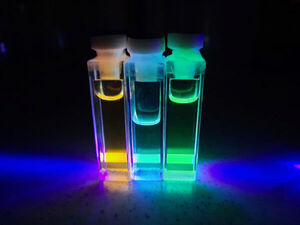
Researchers Present New Synthesis Method for Optically Active Carbon Nanodots
"One of the most remarkable carbon-based nanomaterials are luminescent carbon dots, the physical and chemical properties of which are easy to control. Thanks to their low toxicity, these particles are said to possess great potential in the fields of biology and medicine. Carbon dots are made from organic substances; if their precursor contains a chiral center, the resulting nanoparticles will be chiral, too. These particles have various application prospects, including in medical diagnostics. Researchers from ITMO University and St. Petersburg State University, in collaboration with their international colleagues, have developed a new way to synthesize such nanoparticles with stable optical properties. Biomedical progress is largely dependent on production technologies, including novel approaches to the manufacturing and study of nanoparticles." [...]

Fiber glow brings more go for underwater communications
"Optical fibers doped with perovskite nanocrystals bring new opportunities for photodetectors for high-speed, free-space and underwater data links. In free-space and underwater optical wireless communication systems, there is often a trade-off between the size of a photodetector and its bandwidth, with larger area devices capturing more light but at the expense of a slower maximum data speed. Now, researchers from KAUST have developed an elegant solution to the problem. Chun Hong Kang and Boon Ooi and their collaborators have designed and fabricated luminescent polymer optical fibers doped with nanocrystals of CsPbBr3 that act as a large-area scintillator. The idea is that the fibers absorb an optical data signal transmitted in the violet spectral region (around 400 nm) and then reemit it in the green region (around 510 nm) so that it can be detected by a fast avalanche photodetector. The result is a detector system that is omnidirectional and can be scaled to large areas and operate at a data transmission at hundreds of megabits per second, making it especially attractive for fast underwater optical communications." [...]

Charting a safe course through a highly uncertain environment
"A new technique can safely guide an autonomous robot without knowledge of its environmental conditions or the size, shape, or location of obstacles it might encounter. An autonomous spacecraft exploring the far-flung regions of the universe descends through the atmosphere of a remote exoplanet. The vehicle, and the researchers who programmed it, don’t know much about this environment. With so much uncertainty, how can the spacecraft plot a trajectory that will keep it from being squashed by some randomly moving obstacle or blown off course by sudden, gale-force winds? MIT researchers have developed a technique that could help this spacecraft land safely. Their approach can enable an autonomous vehicle to plot a provably safe trajectory in highly uncertain situations where there are multiple uncertainties regarding environmental conditions and objects the vehicle could collide with." [...]
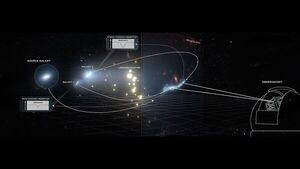
Researchers Use Galaxy as a ‘Cosmic Telescope’ to Study Heart of the Young Universe
"A unique new instrument, coupled with a powerful telescope and a little help from nature, has given researchers the ability to peer into galactic nurseries at the heart of the young universe. After the big bang some 13.8 billion years ago, the early universe was filled with enormous clouds of neutral diffuse gas, known as Damped Lyman-α systems, or DLAs. These DLAs served as galactic nurseries, as the gasses within slowly condensed to fuel the formation of stars and galaxies. They can still be observed today, but it isn’t easy. “DLAs are a key to understanding how galaxies form in the universe, but they are typically difficult to observe since the clouds are too diffuse and don’t emit any light themselves,” says Rongmon Bordoloi, assistant professor of physics at North Carolina State University and corresponding author of the research. Currently, astrophysicists use quasars – supermassive black holes that emit light – as “backlight” to detect the DLA clouds." [...]

Photonics is transforming tech as we know it, here’s how
"From developing an early screening tool for ovarian cancer to powering the world’s fastest internet, the science of light is transforming technology and could hold the key to a vibrant new era for Australian manufacturing. When you use the internet, turn on your smart TV or switch on some LEDs to light your home, you’re reaping the benefits of photonics – the science of generating, manipulating and using light. Critical tools like laser systems, 3D printers, microscopes and medical diagnostics also rely on this critical, though little-known, field. Light is the fastest way to transmit information, making it appealing for real-world applications across industries including aerospace, biomedicine and internet communications. The broad range of applications powered by photonics has made it a booming industry, contributing $4.3 billion to the Australian economy and employing more than 9,500 people in high-tech jobs – according to an industry review. As the federal government examines ways to revitalise Australia’s manufacturing base, photonics offers a new way forward." [...]

Is it topological? A new materials database has the answer
"Searchable tool reveals more than 90,000 known materials with electronic properties that remain unperturbed in the face of disruption. What will it take to make our electronics smarter, faster, and more resilient? One idea is to build them from materials that are topological. Topology stems from a branch of mathematics that studies shapes that can be manipulated or deformed without losing certain core properties. A donut is a common example: If it were made of rubber, a donut could be twisted and squeezed into a completely new shape, such as a coffee mug, while retaining a key trait — namely, its center hole, which takes the form of the cup’s handle. The hole, in this case, is a topological trait, robust against certain deformations." [...]

Ditching sensors for streamlined control of microdevices
"A single-actuator system allows sensor-free highly precise position control for microelectromechanical devices. The ability to precisely control the position and movement of miniature devices is being taken into new territory as KAUST scientists develop tinier and simpler devices without a single sensor. Positioning miniature microelectromechanical devices in industrial or medical applications traditionally relies on a combination of actuators that cause movement and sensors that detect position, explains postdoc Hussein Hussein. “Our novel approach gets rid of sensors,” he says. The prototype devices also use a single actuator rather than the several usually required. Having a single actuator enabled the researchers to reduce the size of their devices and also reduce the complexity of the electronics and power supply." [...]
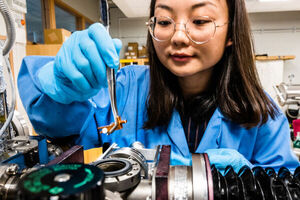
New light on organic solar cells
"Efficient and environmentally friendly solar cells are required for a transition to a fossil-free energy supply. Researchers at Linköping University have mapped how energy flows in organic solar cells, something that previously had been unknown. The results, which can contribute to more efficient solar cells, are published in Nature Communications. “To enable the full potential of organic solar cells to be exploited, there is a need for a clear picture of how they work. We have now obtained that picture. This provides a better understanding of how to create new efficient and sustainable solar cell materials,” says Mats Fahlman, a professor at the Laboratory of Organic Electronics at Linköping University." [...]
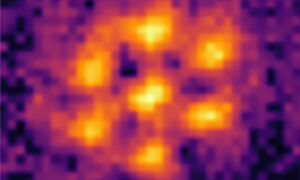
Supersolids go circular 2D
"In a new study, investigations led by Francesca Ferlaino and Russell Bisset show how to cool an atomic gas into a supersolid with a circular, 2D shape. The method will allow researchers to further study these exotic states of matter and search for features such as turbulent vortices. In recent years a new state of matter has appeared on the scene: the supersolid. This has both the crystal structure of a solid and the properties of a superfluid, a quantum fluid that can flow without friction. The team led by Francesca Ferlaino from the Department of Experimental Physics at the University of Innsbruck and the Institute for Quantum Optics and Quantum Information at the Austrian Academy of Sciences in Innsbruck was among the first to generate supersolid states in ultracold quantum gases of magnetic atoms. In a new study, they show that an established method for forming supersolids in a one-dimensional crystal – by tuning how the particles interact with one another – fails to reach supersolidity in two dimensions." [...]

How a cognitive bias is blocking the rise of electric cars
"A UNIGE team shows that underestimating battery autonomy is a major psychological barrier to buying an electric car. What are the barriers to the adoption of electric cars? Although the main financial and technological obstacles have been removed, their market share still needs to increase. In a recent study, a team from the University of Geneva (UNIGE) investigated the cognitive factors that still dissuade many people from switching to electric cars. They found that car owners systematically underestimate the capacity of electric driving ranges to meet their daily needs. These results, published in Nature Energy, open up new avenues to speed up the electrification of mobility in addition to conventional policy approaches." [...]
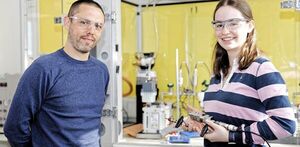
Low-cost battery-like device absorbs CO2 emissions while it charges
"Researchers have developed a low-cost device that can selectively capture carbon dioxide gas while it charges. Then, when it discharges, the CO2 can be released in a controlled way and collected to be reused or disposed of responsibly. The supercapacitor device, which is similar to a rechargeable battery, is the size of a two-pence coin, and is made in part from sustainable materials including coconut shells and seawater. Designed by researchers from the University of Cambridge, the supercapacitor could help power carbon capture and storage technologies at much lower cost. Around 35 billion tonnes of CO2 are released into the atmosphere per year and solutions are urgently needed to eliminate these emissions and address the climate crisis. The most advanced carbon capture technologies currently require large amounts of energy and are expensive." [...]

'Night-time solar' technology can now deliver power in the dark
"Innovative research from a UNSW team shows Earth’s radiant infrared heat can be used to generate electricity, even after the sun has set. UNSW researchers have made a major breakthrough in renewable energy technology by producing electricity from so-called ‘night-time’ solar power. The team from the School of Photovoltaic and Renewable Energy Engineering generated electricity from heat radiated as infrared light, in the same way as the Earth cools by radiating into space at night. A semiconductor device called a thermoradiative diode, composed of materials found in night-vision goggles, was used to generate power from the emission of infrared light. The results of the research have now been published in ACS Photonics. Although the amount of power generated at this stage is very small – around 100,000 times less than that supplied by a solar panel – the researchers believe the result can be improved in the future." [...]

A new step in the search for room-temperature superconductors
"Scientists have found a new, nanoscale link between superconductivity — the flow of electric current without a loss of energy — and a phenomenon known as charge density waves. The discovery, which is described in the journal Science, is a tantalizing step in the decades-long search for room-temperature superconductors that could unleash a new generation of electronics and computers. The vast majority of superconducting materials operate at intensely cold temperatures, typically below -320 degrees Fahrenheit, making them impractical to use without a cooling system. Developing superconductors that operate at warmer temperatures could transform everything from laptop computers to regional power grids. “Knowing what makes these materials superconductors gets us closer to being able to control them. We’re looking for any connection that relates to their superconductivity,” said Eduardo H. da Silva Neto, an assistant professor of physics in Yale’s Faculty of Arts and Sciences and co-author of the new study." [...]

New Device Creates Different Images Depending on Light and Environmental Conditions
"Metasurface-based technology could be used to optically encrypt information Researchers have developed a new metasurface-based device that can produce multiple distinct holographic images depending on the surrounding medium and the wavelength of light used. The ability to store information that is only retrievable with the right set of keys — such as a certain light wavelength combined with wet conditions — could be further developed to design simple yet effective encryption devices. “Our new metasurfaces give an immediate and simple readout of the environment surrounding the surface of the device,” said research team leader Andrea Di Falco from the University of St. Andrews in the U.K. “In addition to encryption applications, this could be used as a humidity sensor or as part of more complex light-based biomedical systems.” In the Optica Publishing Group journal Optics Express, the researchers demonstrate a device that reveals a holographic butterfly with 705-nm light in dry conditions and a caterpillar when 750-nm light is combined with wet conditions. When 660-nm light is used in dry conditions, both images are visible. The selective response of the metasurfaces can be tailored to work with various pre-programmed conditions. “Our holographic devices contribute to the worldwide effort to develop the physics and applications of photonic metasurfaces, which are one of the most versatile photonic tools available to researchers to encode and manipulate information using light,” said Di Falco." [...]

Columbia Physicists Shine New Light on an Old Quantum Optics Problem About Collective Behavior
"Calculations from Ana Asenjo-Garcia and Stuart Masson reveal that any atom array is capable of bursting—a sign that atoms are syncing up. When atoms interact with each other, they behave as a whole rather than individual entities. That can give rise to synchronized responses to inputs, a phenomenon that, if properly understood and controlled, may prove useful for developing light sources, building sensors that can take ultraprecise measurements, and understanding dissipation in quantum computers. But can you tell when atoms in a group are synced up? In new work in Nature Communications, Columbia physicist Ana Asenjo-Garcia and her postdoc Stuart Masson show how a phenomenon called a superradiant burst can indicate collective behavior among arrays of atoms, solving what’s been a decades-old problem for the field of quantum optics. Shining a laser on an atom adds energy, putting it into what’s known as an “excited” state." [...]

Component for brain-inspired computing
"Researchers from ETH Zurich, the University of Zurich and Empa have developed a new material for an electronic component that can be used in a wider range of applications than its predecessors. Such components will help create electronic circuits that emulate the human brain and that are more efficient at performing machine-learning tasks. Compared with computers, the human brain is incredibly energy efficient. Scientists are therefore drawing on how the brain and its interconnected neurons function for inspiration in designing innovative computing technologies. They foresee that these brain-inspired computing systems, will be more energy efficient than conventional ones, as well as better at performing machine-learning tasks. Much like neurons, which are responsible for both data storage and data processing in the brain, scientists want to combine storage and processing in a single electronic component type, known as a memristor." [...]

Physicists explain how type of aurora on Mars is formed
"Physicists led by the University of Iowa have learned how a type of aurora on Mars is formed. In a new study, the physicists studied discrete aurora, a light-in-the-sky display that occurs mostly during the night in the red planet’s southern hemisphere. While scientists have known about discrete aurora on Mars–which also occur on Earth—they did not know how they formed. That’s because Mars does not have a global magnetic field like Earth, which is a main trigger for aurora, also called the northern and southern lights on our planet. Instead, the physicists report, discrete aurora on Mars are governed by the interaction between the solar wind—the constant jet of charged particles from the sun—and magnetic fields generated by the crust at southern latitudes on Mars. It’s the nature of this localized interaction between the solar wind and the crustal magnetic fields that lead to discrete aurora, the scientists find." [...]
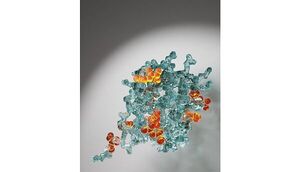
Magnetic resonance makes the invisible visible
"Hyperpolarised water boosts signal intensities of proteins, DNA, and membranes A small group of researchers including Dennis Kurzbach from the Faculty of Chemistry of the University of Vienna just published in "Nature Protocols" an advanced NMR (Nuclear Magnetic Resonance) method to monitor fast and complicated biomolecular events such as protein folding. For example, protein folding was long considered as one of the great mysteries of modern research. This crucial process during which amino acid chains adopt a 3D structure and functionality, takes place within milliseconds. Being this fast, protein folding events could often not be characterized by NMR spectroscopy; the standard method for studying molecular structures. Employing hyperpolarized water, researchers have now developed a method that dramatically enhances the signals of the proteins, nucleic acids, and other biomolecules. This renders monitoring of processes such as protein folding possible." [...]

Newly Discovered Enzyme Breaks Down Pet Plastic In Record Time
"Plastic bottles, punnets, wrap – such lightweight packaging made of PET plastic becomes a problem if it is not recycled. Scientists at Leipzig University have now discovered a highly efficient enzyme that degrades PET in record time. The enzyme PHL7, which the researchers found in a compost heap in Leipzig, could make biological PET recycling possible much faster than previously thought. The findings have now been published in the scientific journal “ChemSusChem” and selected as the cover topic. One way in which enzymes are used in nature is by bacteria to decompose plant parts. It has been known for some time that some enzymes, so-called polyester-cleaving hydrolases, can also degrade PET." [...]
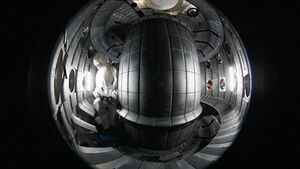
A new law unchains fusion energy
"Physicists at EPFL, within a large European collaboration, have revised one of the fundamental laws that has been foundational to plasma and fusion research for over three decades, even governing the design of megaprojects like ITER. The update shows that we can actually safely use more hydrogen fuel in fusion reactors, and therefore obtain more energy than previously thought. Fusion is one of the most promising sources of future energy. It involves two atomic nuclei combining into one, thereby releasing enormous amounts of energy. In fact, we experience fusion every day: the Sun’s warmth comes from hydrogen nuclei fusing into heavier helium atoms. There is currently an international fusion research megaproject called ITER, which aims to replicate the fusion processes of the Sun to create energy on the Earth." [...]
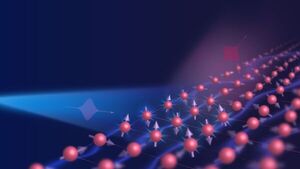
Spin keeps electrons in line in iron-based superconductor
"Researchers from PSI’s Spectroscopy of Quantum Materials group together with scientists from Beijing Normal University have solved a puzzle at the forefront of research into iron-based superconductors: the origin of FeSe’s electronic nematicity. Using Resonant inelastic X-ray scattering (RIXS) at the Swiss Light Source (SLS), they discovered that, surprisingly, this electronic phenomenon is primarily spin driven. Electronic nematicity is believed to be an important ingredient in high-temperature superconductivity, but whether it helps or hinders it is still unknown. Their findings are published in Nature Physics. Near PSI, where the Swiss forest is ever present in people’s lives, you often see log piles: incredibly neat log piles. Wedge shaped logs for firewood are stacked carefully lengthways but with little thought to their rotation." [...]
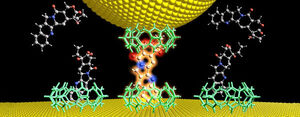
Jacobs University Researchers Develop New Measurement Method In Molecular Electronics
"Controlling electrical signals using single molecules enables the miniaturization of transistors in integrated circuits down to the atomic level. This research area of molecular electronics not only paves the way for the next generation of ultra-powerful computers, but also for entirely new electronic systems and methods. The collaborating research groups at Jacobs University Bremen and China's Wuhan University of Science and Technology have now developed a method for measuring the conductivity of individual pharmaceutical and biological molecules. The results of their recently published research work have been selected as a "Hot Paper" by the editors of the renowned journal Applied Chemistry (“Angewandte Chemie"), founded in 1887. The journal classifies the topic as highly relevant in a rapidly changing field of research. In molecular electronics, single molecules are stretched between two electrodes to form an electrically conducting element in which molecular conductivity is then measured." [...]
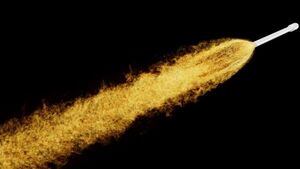
Rocket Engine Exhaust Pollution Extends High into Earth’s Atmosphere
"Reusable space technology has led to a rise in space transportation at a lower cost, as popularized by commercial spaceflights of companies like SpaceX and Virgin Galactic. What is poorly understood, however, is rockets’ propulsion emissions creating significant heating and compositional changes in the atmosphere. In Physics of Fluids, by AIP Publishing, researchers from the University of Nicosia in Cyprus assessed the potential impact of a rocket launch on atmospheric pollution by investigating the heat and mass transfer and rapid mixing of the combustion byproducts for altitudes up to 67 kilometers into the atmosphere. “Improved understanding of rocket emissions requires modeling and simulation of fluid dynamics of rocket exhaust gases into the atmosphere,” said co-author Dimitris Drikakis. The team modeled the exhaust gases and developing plume at several altitudes along a typical trajectory of a standard present-day rocket. They did this as a prototypical example of a two-stage rocket to transport people and payloads into Earth’s orbit and beyond." [...]
Projetos Maker
Diversos Projetos interessantes.

Current-Sense Amplifier with Dual Over Current Level Monitor & Alert Output
"The project presented here is a high common-mode current sense amplifier with two high-speed comparators to detect out-of-range current conditions. The comparators are configured to detect and respond to dual over current conditions. These devices feature an adjustable limit threshold range for each comparator set using an external limit-setting resistor. Limit 1 Resistor is R10 and Limit 2 Resistor is R11. The board measures differential voltage signals on common-mode voltages that can vary from 0 V up to +36 V, independent of the supply. The project is built using an INA302A1 chip which has a gain of 20V/V." [...]
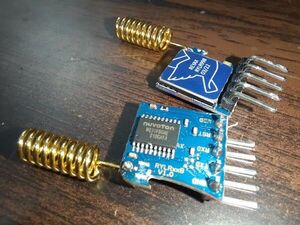
Getting started with LoRa + AT commands
"MIDI controller-filter-router, sound generator, available in kit or fully assembled. Designed by pangrus' electro acoustic lab in Italy. I got my hands on REYAX Lora modules, and in this tutorial, we will configure these modules to communicate with each other. Lora platform is known for its long range as specified by the name LoRa (Long range radio). The normal communication distance is 8Km with rubber ducky antenna. Internet is not required in these trans-receiver modules." [...]

Arduino Cranial Stimulator (Bio-BrainTuner)
"Cranial electro stimulation uses harmonic frequencies to help balance the brain's chemistry. Cranial electro stimulation uses harmonic frequencies to help balance the brain's chemistry. By connecting with the body's control center, the brain harmonic frequencies provide wide-ranging and extensive benefits in a painless and non-invasive manner, with little or no side effects: - Relieves stress - Regain mental acuity and clarity - Helps with addictions & cravings - Relief from insomnia - Enhance meditation experiences - Pain management etc... A project for making such a device was recently presented in a local magazine, but the device was relatively complex and contained 6 Integrated Circuits. In a very simple way can be made similar device with the help of Arduino microcontroller and a few discrete elements. The basic idea and code is from the nvtronics.org forum. I extended the code with a simple 20 min timer, which is the recommended time for this type of simulation." [...]
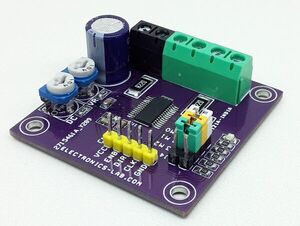
High-performance, High-reliability Bipolar Stepper Motor Driver
"The project presented here is a bipolar stepper motor driver. It is based on BD63731EFV chip which is a low-consumption driver that is driven by a PWM signal. The power supply voltage of the project is 8 to 28V DC, and the rated output current is 3A. CLK-IN driving mode is adopted for the input interface, and excitation mode is corresponding to FULL STEP mode (2 types), HALF STEP mode (2 types), QUARTER STEP mode (2 types), 1/8 STEP mode, and 1/16 STEP mode via a built-in DAC. In terms of current decay, the SLOW DECAY/FAST DECAY ratio may be set without any limitation, and all available modes may be controlled in the most appropriate way. In addition, the power supply may be driven by one single system, which simplifies the design." [...]
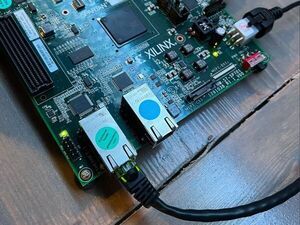
Automated Control of SP701 Over LAN using lwIP
"This project shows how to use an lwIP server on the SP701 to be able to send it commands/data on a local area network (LAN). With the transition from Spartan 6 to Spartan 7 in full swing, I decided that my SP701 needed to be added to my network for remote control access, specifically using the lwIP stack since I've previously demonstrated how to set up that bare metal C application in Vitis. I'm starting this project using the Vivado hardware design from 2021.2 I did in this project and I'm starting with the embedded C lwIP application that I created in Vitis here. My goal for this project is to expand the echo server application running on the SP701 to include actions to specific commands received from the Python echo client script running on the host PC on top of it echoing back the string it receives. There are 8 LEDs on the SP701 that are perfect for a quick add functionality-wise so I'll be adding the capability to turn off/on each of the 8 LEDs individually or altogether to the echo server application in Vitis then writing a new Python script echo client to test out the remote control of the LEDs. GPIO Control Functions In the hardware design for the SP701 in Vivado, the 8 LEDs are controlled by their own AXI GPIO block in the block design." [...]
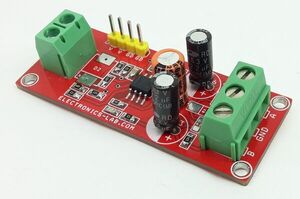
Piezo Element Amplifier for Guitar and Violin
"The board presented here is a preamplifier for contact microphones that are used for amplifying the sound of musical instruments which do not contain electrical pickups, such as guitar and violins. Most contact microphones use a piezo element to convert vibration in the body of the musical instrument to a voltage. The circuit is built using OPA1678 OPAMP. The low noise and low input bias current of the OPA1678 makes the device an excellent choice for high impedance preamplifiers for piezo elements. This preamplifier circuit provides high input impedance for the piezo element but has low output impedance for driving long cable runs. It provides a balanced audio output that can be fed to a balanced microphone pre-amplifier." [...]

Modularized Narrowband FM Receiver
"MC3362 and ADF4351 based, modularized, NFM receiver. This receiver is designed to listen to the 2m band amateur radio conversations. This project is about MC3362and ADF4351based modularized, 2-meter narrow band FM receiver. In this design, the receiver splits into three modules as RF preamplifier, MC3362 tuner, and ADF4351 oscillator. The RF preamplifier builts around BF900 dual-gate MOSFET. The tuner stage builts using the popular MC3362, low power narrowband FM receiver IC." [...]
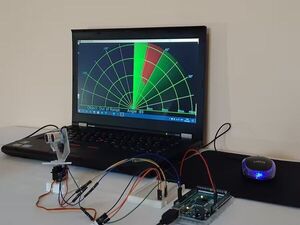
Arduino Radar with Led diode and encoding data onto an image
"Practical development of the radar system for detection of objects at short distances and encoding data onto an image using QuickStego tool. Introduction for the project Through the practical development of the radar system for detection of objects at short distances, material is shown for connecting the digital development electronic board Arduino Mega 2560 (programmed with integrated development environment Arduino IDE) with a personal computer that uses a program made with Processing software that allows computer to display the view of a particular object that is detected by the radar system for detection of objects at short distances. The practical development of the radar system for detection of objects at short distances will also show the way of practical connection of all necessary digital electronic components and their programming in order to show the importance of the use of the scientific field of digital electronics and programming in education. process in various other scientific fields and disciplines. Additionally, MS windows software "Processing" was used to receive the data from the Arduino and to draw the radar image on the personal computer. " [...]
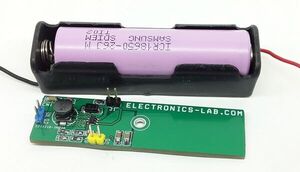
Li-Ion/Li-Po 18650 Battery to 5V Boost Converter
"The project presented here is capable of supplying 400mA of current from a 3.7V Li-Ion/Li-Po Battery input with a 5V output. The converter has an internal soft start and internal frequency compensation features. The project is built using LTC3426 SOT23-6 chip. The LTC3426 chip is in a low profile (1mm) SOT-23 package and has a very low shutdown current of about 0.5µA. A switching frequency of 1.2MHz allows a tiny solution. The tiny PCB can be mounted on the backside of the a 18650 battery holder." [...]
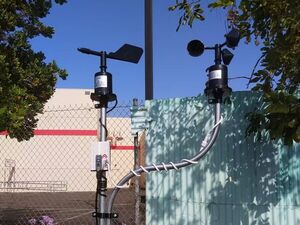
EMT Conduit-Mounted Wind Sensors with Arduino
"I present a method to continuously measure wind speed and wind direction as part of a custom weather station project. This article is part of a series discussing methods for adding sensing capabilities to a DIY telescoping pole project made from EMT conduit. Here I present a method for using simple off-the-shelf electronics to continuously measure (1) wind speed, and (2) wind direction as part of a custom weather station project. Weather stations, both commercially-available and do-it-yourself (DIY), feature one or more of the following sensing capabilities: - Wind speed (anemometer) - Wind direction (weather vane) - Air pressure (barometer) - Humidity (hygrometer) - Volume of rain (rain gauge) - Air temperature (thermometer) Commercial weather stations available for online purchase are convenient, but are also often: - Expensive - Non-customizable - Near-impossible to interface with hobbyist controllers such as Arduino or Raspberry Pi Regardless, these kinds of products are still sometimes the best option for home weather station projects - in those cases, a telescoping pole constructed from EMT conduit (readily available from hardware stores such as Home Depot or Lowes) made using a telescoping coupling can serve as a low-cost and study mount such all-in-one weather stations. For all other situations where a DIY solution is more appropriate for your project, in this article we present a method to measure and log wind speed and wind direction using low-cost, off-the-shelf electronics and hardware. More functionality can be added to this platform with the optional electronics modules listed below." [...]

Power-Saving PWM Solenoid Controller
"The project described here is a power-saving pulse-width modulator (PWM) controller for solenoids with an internal supply regulator. The board is based on the DRV110 IC which is a PWM current controller which is specifically designed for solenoid and relay applications. The project regulates the current with a well-controlled waveform to reduce power dissipation on the load. The solenoid current is ramped up fast to ensure the opening of the valve or relay. After initial ramping, the solenoid current is kept at a peak value to ensure correct operation, after which the current is reduced to a lower hold level to avoid thermal problems and reduce power dissipation. " [...]
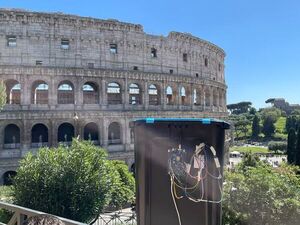
checkBin
"Through a network of intelligent devices we want to monitor the fill level of trash bins to have a real time view of the situation. The main problem of waste management in a lot of big cities is overflowing bins. This brings to garbage left on the streets, bad smells, wild animals roaming and fed up citizens. It is the consequence of an inefficient usage of the resources by garbage pickup companies, both economical and logistical (employees time and garbage trucks). As an example it happens that the usual pickup route empties not yet full bins missing the full ones. IoT could help solve this problem without having to hire new workers nor buying new trucks, which would generate more long term expenses for the company." [...]

Create text animations with Parola Library for Arduino
"Make cool looking text animations/transitions on 8x8 dot matrixes controlled by MAX7219 modules" [...]
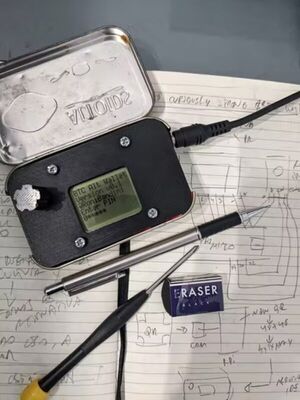
A curiously cold Bitcoin wallet
"A friend of mine was an early Bitcoin adopter with a hold strategy using paper wallets. He stored his paper wallets inside an Altoids Tin, and the Altoids tin inside a safe. After several years, the ink started to fade. My friend doesn't trust commercial hardware wallets (“Black boxes, you know...”) and online platforms (“Didn't we learn something after MtGox?”). So I’ve decided to give it a try and develop a basic experimental cold hardware wallet with the following requirements: #1 Little enhancement over paper wallets #2 Should fit the same Altoids tin After a few days... I've came out with the Alt Wallet." [...]
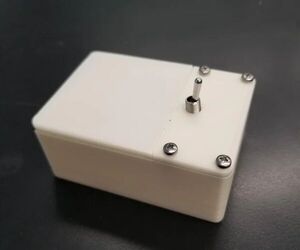
Useless Machine Using 555 Timer
"This was by far the coolest machine I came across when deciding what to build for my final project, even though it really is the most useless machine in the world. I remember seeing this concept when I was a kid and always wanting to build one of my own. It is a very basic idea, you flip a switch on and a motorized arm comes out of the box to turn itself off. This involves a micro server or geared motor, two switches, and a battery pack. The switches consist of a toggle switch and a micro switch. The micro switch will be wired to work opposite of how it usually works and the toggle switch starts in the reverse direction." [...]

3D Printed Clock With Perpetual Calendar
"Clock with Perpetual Calendar The perpetual calendar is one of the representative mechanism of complication clocks and watches. It shows correct date until 2099 without adjustments because it can handle all kind of month lengths including February of leap years. Features are as follows. - This clock has four sub-dials to show 24hours, month, date and day of the week - Easy calendar adjustment by direct manipulation of hands - No bearings or metal shafts but works smoothly - You do not need supports to print - It can be printed out by relatively smaller printers including Prusa MINI (size of maximum part is 180 x 180mm) Necessary parts - 28BYJ-48 geared stepper motor and driver circuit comes with - Arduino nano or other micro controller - One tactile switch - 2mm tapping screws (It needs various length of 2mm tapping screws. It is recommended to purchase an assortment of 2mm tapping screws. Please search in amazon.com with “m2 tapping screw assortment”.)" [...]

Ne555 Breathing Effect
"This is a simple ne555 timer IC based multi vibrator breathing effect . The LED blinks like we breathe we can control the breathing time using potentiometer on board. It works on 5 volts DC to 9 volts DC. The working of this is simple that the n e 555 produces a frequency or a signal which then activate a general purpose NPN transistor which bank switches on and of the LED . The breathing effect is produced due to the charging of a capacitor which turns on the emither collector path for a short amount of time until the capacitor gets drained. Supplies - Ne 555 timer IC - General purpose NPN transistor - 10 kilo ohms variable resistor - 10 kilo ohm resistor - 100 UF capacitor - 470 UF capacitor - 3 volt LED lights - Solid copper wire - Wooden base" [...]
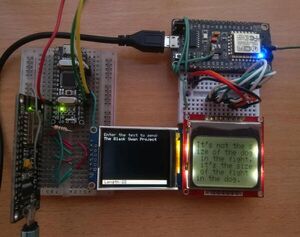
The Black Swan Project
"The Black Swan Project is an ESP8266-based, secure, one-way communication channel. It might be superfluous in the current conditions. But let's suppose that a black swan event occured, causing the nationwide blackout, complete failure of the mobile network, or other unpleasant consequences. It might seem like all electronic means of communication have disappeared (maybe except for radios and Bluetooth). Well, not all. Don't get me wrong, I'm not trying to tell you that this device will immediately fix the situation and bring the paradise to the earth, but at least it can be "a beam of hope in the sea of darkness," at least you will be able to text your neigbhor." [...]

Tiny Solar Cell
"This time I share with you an easy STEM project to show the kids how a solar cell works. This little device collects clean renewable energy in the form of sunlight and convert that light into electricity which can then be used to provide power to light several 5 mm leds. The solar array sends direct current (DC) electricity to the battery, a 4700 microfarad capacitator I hope you like it Supplies: - Six 5 mm green leds - Ten 1N4001 diodes - Two 4700 microfarad capacitators - Two micro switches push button" [...]

Arduino Nano Quadruped Robot
"My name is Jaylan and I made this project for my Principles of Engineering class with Ms. Berbawy. It took around 6 months to finish due to only working on it on some days of the week. This Instructable will go through my building process for creating the Arduino Quadruped. I wanted to build this project after I saw a picture of a Minikame Quadruped in Hackspace Magazine. I also saw many other creations on Instructables like an QUATTRO created by Technovation and the 3D Printed Quadruped from Ijunqian. Throughout the whole process I referenced those websites to help me build my 8 DOF Quadruped Robot from scratch." [...]
Secção Videos
Videos interessantes.
That's all Folks!



